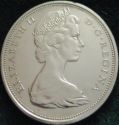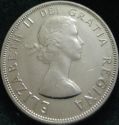
How To Clean Silver Coins
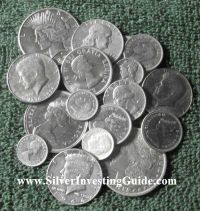 To
gold/silver collectors and precious metals dealers, cleaning
silver coins is taboo - never to be done under any circumstances.
I am in complete agreement about 98 percent of the time. However,
there are times when it is almost a crime not to clean some silver
coins to show their "hidden" beauty. But before you even think
about cleaning any silver coin, there some things you must be
aware of...
To
gold/silver collectors and precious metals dealers, cleaning
silver coins is taboo - never to be done under any circumstances.
I am in complete agreement about 98 percent of the time. However,
there are times when it is almost a crime not to clean some silver
coins to show their "hidden" beauty. But before you even think
about cleaning any silver coin, there some things you must be
aware of...
It is not uncommon for silver coins to have a value over and above the value of their silver content (otherwise known as intrinsic value). Cleaning a coin that is numismatically valuable can destroy that value thereby costing you money (in rare cases, lots of money). If you are tempted to clean your silver coin(s) before finding out their value (based on scarcity, demand, condition, etc.) DON'T.
Here are a few reasons you might want to clean your silver coins. If you have common date silver coins in your personal collection that you would like to shine up, why not do it to better enjoy them? If you have common date silver coins you want to present as gifts to friends, children or grandchildren, shiny coins make great gifts. But if you plan on selling your coins and think shining them up a bit will get you a better price - it won't. Cleaning silver coins (sometimes referred to as "whizzing") is definitely frowned on by dealers and experienced investors.
If you have done due diligence on the coin(s) you want to clean and decided to proceed, two different methods are described below.
Silver Coin Cleaning - Method 1.
The first coin selected for cleaning was a Canadian 1967 Confederation Centennial Commemorative half dollar. The original beauty of this coin is hidden behind the extensive toning. The total mintage of this coin is 4,211,392 and, as a circulated coin, it is worth its intrinsic value (plus the current premium) and no more. To figure out the intrinsic silver value of this half dollar, multiply .2925 (the silver content a circulated 80 percent half dollar is considered to contain) times the current spot price of silver.
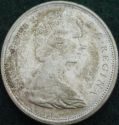 To clean this coin I used a commercially available product (Weiman
Royal Sterling Silver Polish). Placing an amount
of polish about the size of the silver coin on a soft cloth, fold
the cloth in half (which gets polish on both halves) then place
the coin in between. Rubbing the coin in the cloth using your
thumb and index finger, you can clean both sides at once.
To clean this coin I used a commercially available product (Weiman
Royal Sterling Silver Polish). Placing an amount
of polish about the size of the silver coin on a soft cloth, fold
the cloth in half (which gets polish on both halves) then place
the coin in between. Rubbing the coin in the cloth using your
thumb and index finger, you can clean both sides at once. 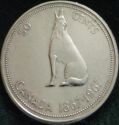
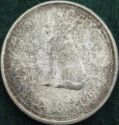 Then
wipe the coin on a clean part of the cloth to remove the polish
and get the shine you see on the right. You will end up with a
very dirty cloth and a very shiny silver coin. I spent just a few
minutes to get the results which is about 98% clean. Click on the
images for a larger view.
Then
wipe the coin on a clean part of the cloth to remove the polish
and get the shine you see on the right. You will end up with a
very dirty cloth and a very shiny silver coin. I spent just a few
minutes to get the results which is about 98% clean. Click on the
images for a larger view.
Silver Coin Cleaning - Method 2.
The next coin selected for cleaning was a Canadian 1958 British Columbia Commemorative silver dollar. The toning on this coin is not as extensive as the one above but enough to make this dollar less than appealing to the eye. The total mintage of this coin is 3,039,630 and even in the upper circulated grades of Very Fine (VF), Extremely Fine (EF or XF) and About Uncirculated (AU), it is worth a little over its intrinsic value plus the current premium. To figure out the intrinsic silver value of this dollar, multiply .6 (the silver content a circulated 80 percent dollar is considered to contain) times the current spot price of silver.
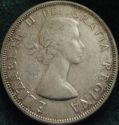 To clean this coin I used a liquid solution (Tarn-X)
that removes tarnish from various metals including silver. To
proceed with cleaning a coin, pour a small amount of the liquid in
a container - just enough to cover the coin when laying flat.
Immerse the coin for a few seconds, remove and rinse in cold
water, then carefully dry with a soft cloth. The results are
almost
To clean this coin I used a liquid solution (Tarn-X)
that removes tarnish from various metals including silver. To
proceed with cleaning a coin, pour a small amount of the liquid in
a container - just enough to cover the coin when laying flat.
Immerse the coin for a few seconds, remove and rinse in cold
water, then carefully dry with a soft cloth. The results are
almost 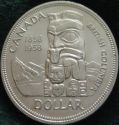
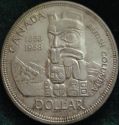 immediate
with the toning literally melting away before your eyes.
This is the least harmful method of silver coin cleaning and, if a
dealer were to ever clean a coin, this is probably the method they
would use. Click on the images for a larger view.
immediate
with the toning literally melting away before your eyes.
This is the least harmful method of silver coin cleaning and, if a
dealer were to ever clean a coin, this is probably the method they
would use. Click on the images for a larger view.
It is questionable as to whether this coin should be cleaned at all. My reason for cleaning this coin is so that it would display better in my Kindle eBook The Last Canadian 80 Percent Silver Coins - A Buying & Selling Guide which features this and 28 other Canadian silver coins. If not for this, I probably would have left this silver dollar in its toned state.
Cleaning Silver Coins With Baking Soda. Another method of cleaning silver coins is with inexpensive baking soda. To clean a coin this way, make a watery paste of baking soda and water in a small container. Dip the entire coin in the paste, then rub both sides with your thumb and index finger for a minute or so. Rinse with water and wipe dry with a soft cloth. Repeat if necessary to achieve the desired results. Using baking soda is a little more abrasive than the dipping method but the results can be quite good - especially where small crevices exist around the image and lettering.
There you have three effective methods of cleaning silver coins. Just remember to research the value of any coin you wish to clean before going ahead or you may be kicking yourself for ruining what could be a small windfall.
